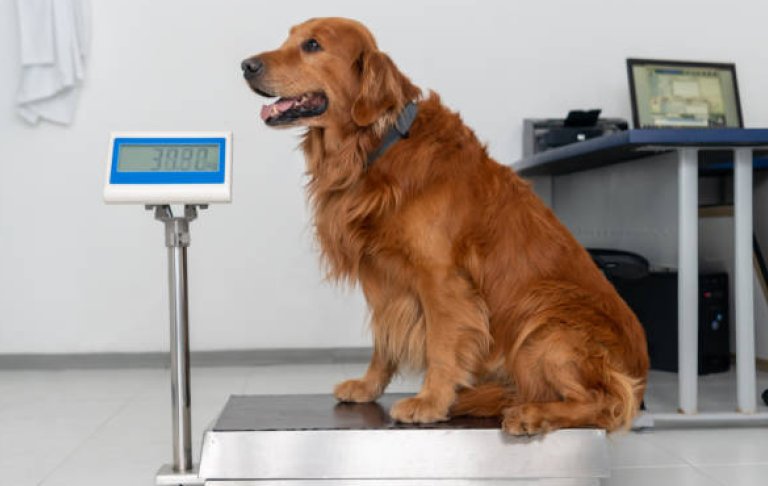Dog itchy ears are more common than you might think. One moment your pup’s relaxed, the next they’re pawing at their ears or shaking their head like crazy. It might seem like a simple itch, but it could be a sign of something more serious.
Ear problems in dogs can start small and quickly turn painful. If left untreated, they can lead to infections, swelling, or even hearing loss. That’s why it’s important to spot the signs early and know when to take action.
This guide walks you through everything you need to know about dog itchy ears. You’ll learn how to recognise symptoms, understand possible causes, and decide when it’s time to call the vet. We’ll also cover what to expect during your visit, treatment options, and simple ways to keep your dog’s ears clean and healthy at home.
Whether you’re a first-time dog owner or you’ve been down this road before, this blog will help you feel more prepared. Because when it comes to your dog’s health, a little knowledge goes a long way.
Signs of Dog Itchy Ears You Shouldn’t Ignore

Dog itchy ears can seem harmless at first. But if you’re not paying attention, small signs can quickly turn into bigger problems. That’s why it’s important to know what to look for before things get worse.
One of the most obvious signs is constant head shaking. If your dog keeps shaking their head throughout the day, it could mean something’s irritating their ears. Alongside this, scratching with a back paw or rubbing the side of the head on floors or furniture is another red flag.
Watch for any discharge from the ear. It could be yellow, brown, or even bloody in some cases. A strong, unpleasant smell—like something yeasty or rotten—is also a clear warning. Healthy dog ears don’t have a strong odour.
Redness, swelling, or visible crust inside the ear flap could point to infection. If you touch the area and your dog pulls away, flinches, or shows signs of pain, that’s another sign something’s wrong. Many dogs also become extra sensitive and avoid being touched around the head.
In more advanced cases, you might notice changes in behaviour. Your dog might become moody, tired, or withdrawn. Some dogs may lose balance, tilt their head to one side, or walk in circles. These signs suggest the problem could be affecting the inner ear, which needs urgent vet care.
Doing weekly ear checks helps you stay ahead of trouble. Lift the ear flap, look for redness or gunk, sniff for any odd smell, and check for sensitivity. You don’t need to be an expert—just being observant goes a long way.
When you spot any of these signs, don’t wait. Dog itchy ears often get worse if ignored. Getting help early can save your dog from pain and stop a small issue from becoming a big one.
What Causes Dog Itchy Ears?
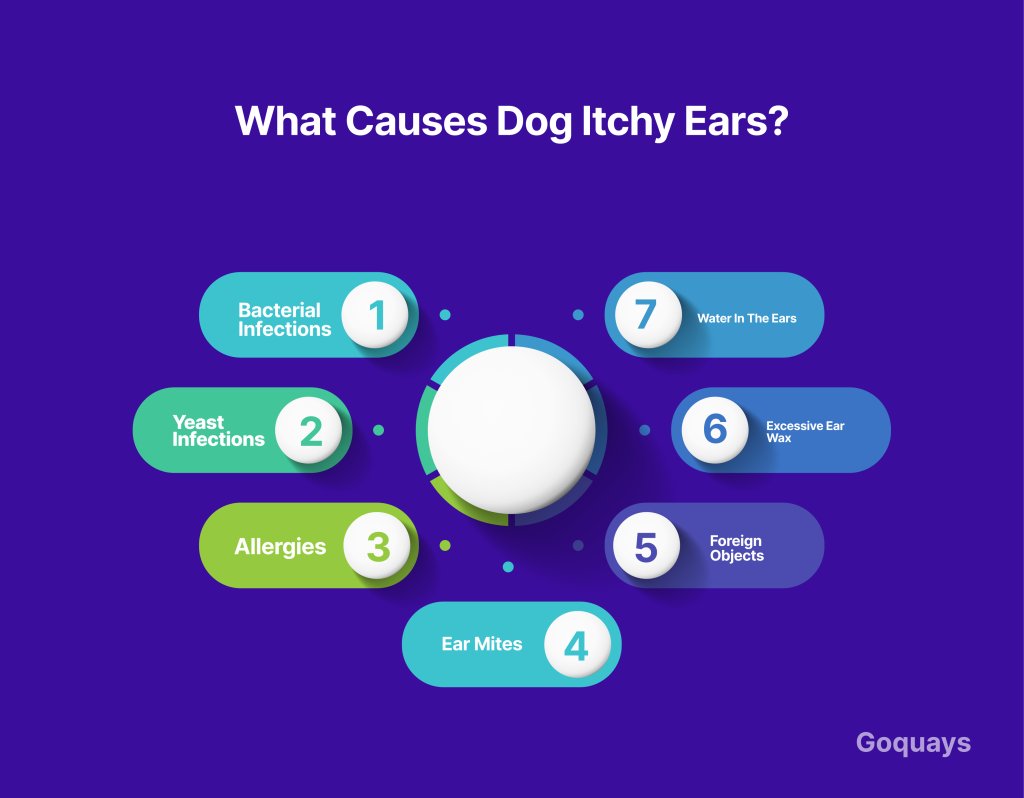
Dog itchy ears can come from many things. If your dog keeps scratching or shaking their head, check for these common causes:
- Bacterial infections: These are one of the top reasons for itchy ears. Moisture, dirt, or wax can trap bacteria inside. You might notice swelling, redness, or a smelly discharge. Dogs with floppy ears or who swim a lot are more at risk.
- Yeast infections: Yeast loves warm, damp places—like inside your dog’s ears. This type of infection often causes a musty or sour smell. The ears may look greasy, dark, or crusty. Dogs with allergies often get yeast infections too.
- Allergies: Food and environmental allergies can both trigger ear issues. Dust, pollen, cleaning products, or certain dog foods might be the problem. Look for signs like red, itchy ears, frequent scratching, watery eyes, or sneezing. Both ears are usually affected.
- Ear mites: Though more common in puppies, mites can cause serious itching and discomfort. You may see dark wax buildup or constant scratching. They’re also contagious, especially in shelters or multi-pet homes.
- Foreign objects: Grass seeds, dirt, or other small things can get stuck in your dog’s ear. This can lead to scratching, pain, and even infection if left untreated.
- Excessive ear wax: Too much wax can irritate your dog’s ears. It may also trap bacteria and lead to infections. Regular cleaning helps keep this under control.
- Water in the ears: After a bath or swim, leftover water can cause discomfort and become a breeding ground for bacteria or yeast.
So, are ear infections contagious in dogs? Not usually. Most bacterial or yeast infections aren’t passed between dogs. But if mites are involved, it’s a different story.
If you’re unsure what’s causing the itch, a vet visit is the best next step.
When to Contact a Vet About Dog Itchy Ears
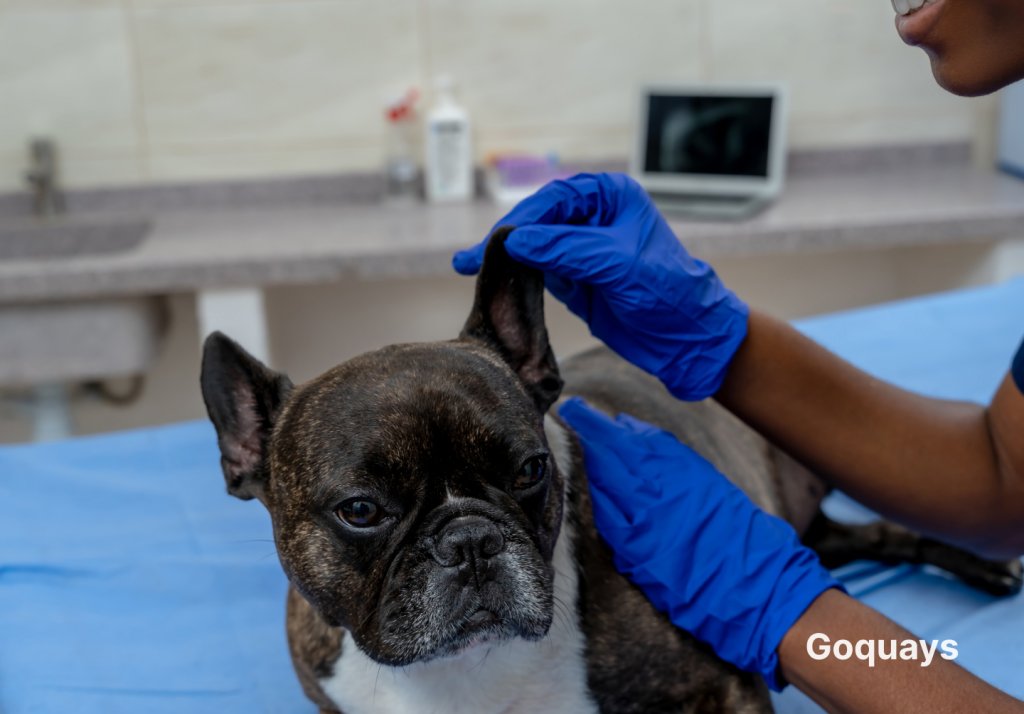
If your dog’s ears are itchy or they’re showing other signs of discomfort, it might be tempting to treat it at home. But when should you contact a vet?
- Persistent symptoms: If your dog’s ear itching, scratching, or shaking lasts for more than a day or two, it’s time to call the vet. Even if you try cleaning their ears or using over-the-counter treatments, long-lasting discomfort needs professional care.
Discharge or foul odor: Notice a thick, yellow, brown, or black discharge? It’s often a sign of an infection. A bad smell coming from the ears is another red flag. If you notice either of these, don’t wait—get a vet’s help.- Redness, swelling, or pain: If your dog’s ears are swollen, red, or hot to the touch, it may indicate an infection or injury. These symptoms won’t get better on their own and should be treated quickly to avoid worsening.
4. Changes in behavior: If your dog is excessively shaking their head, tilting it, or even whining when you touch their ears, it’s a sign they’re in pain. You might also notice them avoiding having their ears touched. This is a clear indication they need a vet’s attention
Can a Dog’s Ear Infection Go Away on Its Own?
Unfortunately, ear infections typically won’t clear up on their own. While some mild cases may improve with basic cleaning, most ear infections—whether bacterial or yeast-related—require specific treatments like medication or ear drops. If left untreated, the infection could worsen and even spread, causing long-term damage to your dog’s ears.
What Happens if You Don’t Treat Your Dog’s Ear Infection?
Ignoring your dog’s ear infection can lead to several issues:
- Chronic infections: Untreated ear infections often come back, leading to a cycle of recurring problems that are harder to treat each time.
- Ear damage: The infection can cause permanent damage to the ear canal or even the eardrum, affecting your dog’s hearing.
- Pain and discomfort: Infections left untreated can become increasingly painful for your dog, leading to severe discomfort.
The sooner you seek treatment, the quicker your dog will feel better and the less risk there is of long-term damage.
What to Expect at the Vet for Dog Itchy Ears
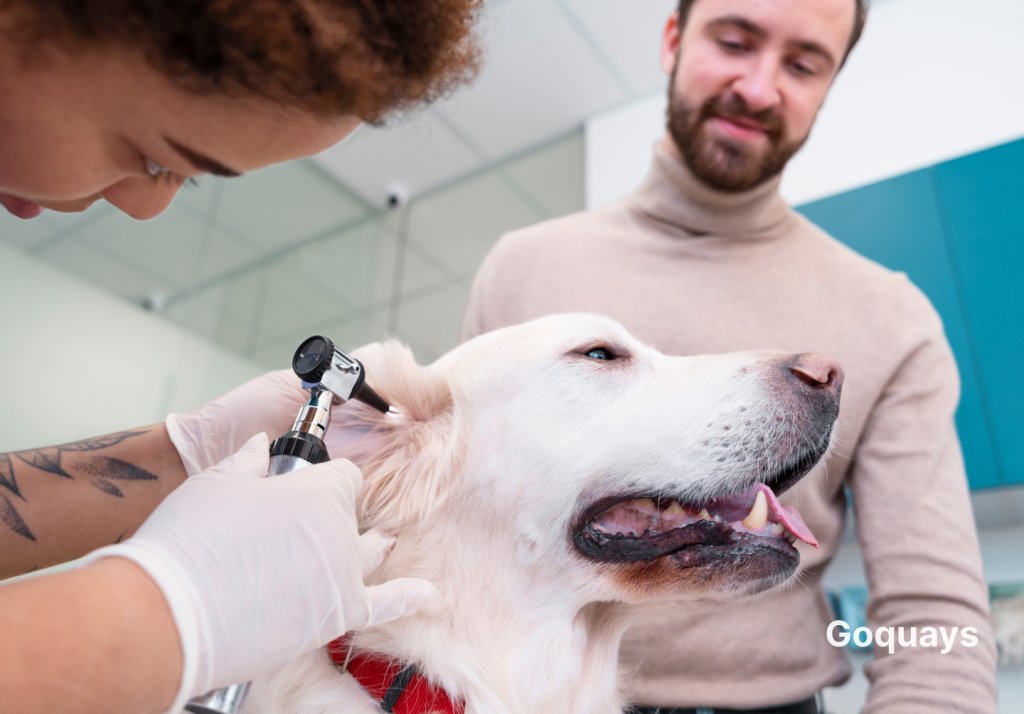
When you take your dog to the vet for itchy ears, expect a thorough examination. The vet will first look at your dog’s ears for signs of infection, redness, swelling, or discharge. They’ll also ask about your dog’s symptoms, including how long the itching has been going on and if there have been any changes in behavior or ear discharge.
The vet may gently clean the ear canal to get a better view and take a closer look at any debris or infection. Based on their findings, they may recommend further tests to determine the exact cause of the itch and develop an appropriate treatment plan.
Tests and Diagnosis
The vet will likely conduct several tests to identify the cause of the ear irritation. An ear swab is commonly taken to examine the ear canal under a microscope. This can help detect infections, such as bacteria or yeast. In some cases, your vet may send the swab to a lab for a culture test to identify the specific bacteria or fungi involved.
If the vet suspects parasites like ear mites, they may test for those as well. In some situations, they might ask about your dog’s environment or diet to rule out allergies as the cause. Based on these tests, your vet can offer a diagnosis and discuss possible treatment options.
Results & Treatment Plan

Once the tests are complete, the vet will share the results and recommend a treatment plan. This could include medications like antibiotics or antifungals, ear cleaning instructions, or possibly steroids if inflammation is present. Your vet will also discuss follow-up visits to ensure your dog’s ear condition is improving and will guide you on preventive measures to avoid future ear problems.
How to Treat Dog Itchy Ears Safely
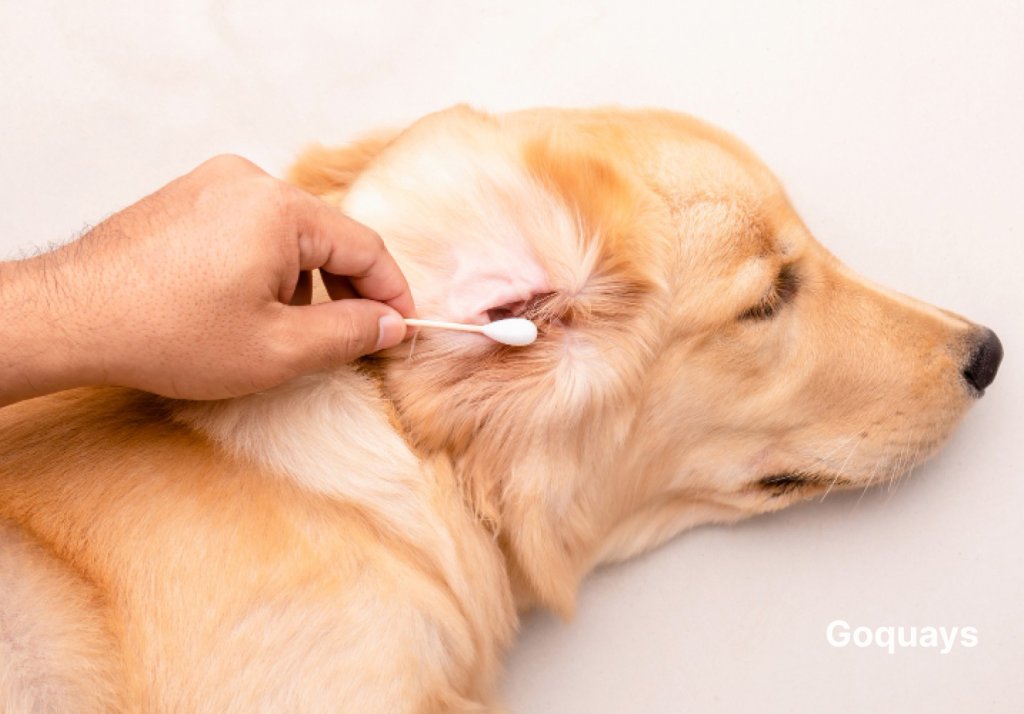
Treating dog itchy ears requires understanding the underlying cause, which may vary from simple irritation to infections. When your dog is dealing with an ear infection, it’s crucial to follow the advice of your veterinarian. Typically, the vet will prescribe ear drops or treatments that contain antifungal, antibacterial, or anti-inflammatory properties to address the infection. These medications are designed to tackle the root cause, whether it’s a bacterial or yeast infection.
If you suspect your dog has an ear infection, it’s important not to attempt to treat it with home remedies or over-the-counter medications without professional guidance. While some products like ear cleaners may help maintain ear hygiene, they’re not enough to cure an infection, especially if it’s advanced. Inappropriate treatments could worsen the issue, leading to chronic infections or more severe problems, like hearing loss.
For general ear care, cleaning your dog’s ears regularly with a gentle, vet-approved ear cleaner can help prevent infections and remove wax buildup. Always use products recommended by your vet, as some household items or human ear cleaning solutions can harm your dog’s sensitive ear canals.
In mild cases, where itching is due to allergies or temporary irritation, you may be able to soothe your dog’s discomfort by applying over-the-counter ear cleaners. However, it’s essential to get a professional diagnosis to ensure there’s no infection or underlying health issue.
If your dog’s ear problem persists or worsens despite at-home treatment, seek veterinary care. Ear infections are unlikely to resolve on their own, and untreated infections can lead to chronic pain and hearing problems. Always consult your vet for the safest, most effective treatment plan tailored to your dog’s needs.
Home Remedies for Dog Itchy Ears
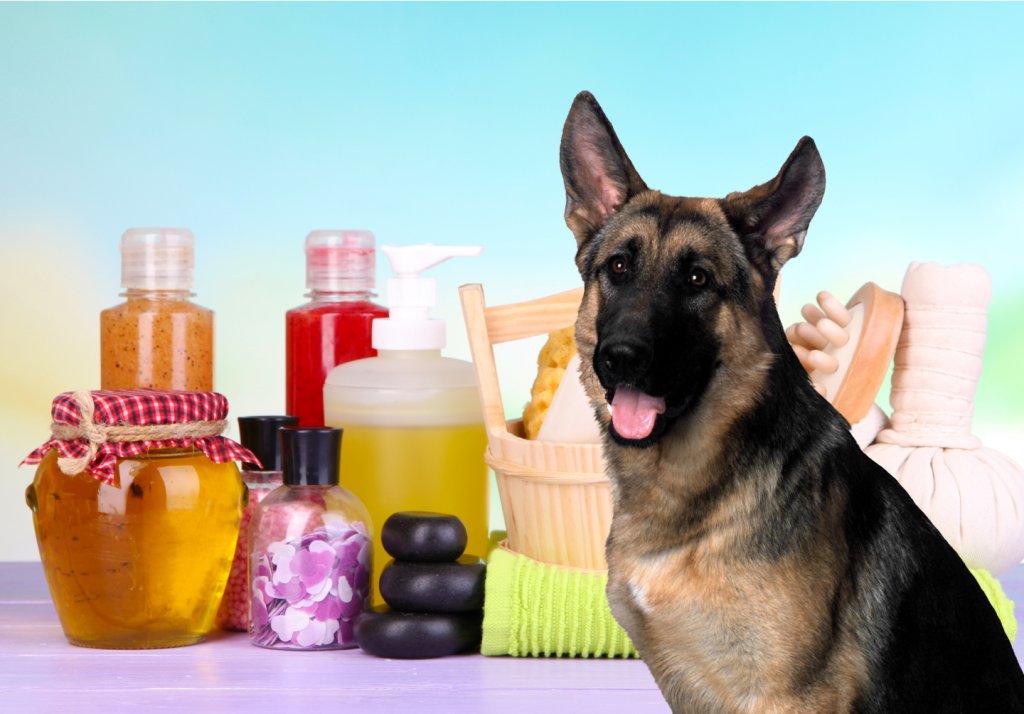
If your dog has mildly itchy ears but no signs of infection, a few safe, vet-approved home remedies might help ease their discomfort. These simple treatments can soothe irritation and keep things from getting worse. Still, if your dog’s symptoms stick around or get worse, it’s time to call the vet.
One of the most effective options is a dog-specific ear cleaner. These solutions help remove dirt, wax, and debris that can build up and cause itching. Gently wipe the outer part of your dog’s ear with a cotton ball soaked in the solution. Avoid using Q-tips or pushing anything deep into the ear canal. Regular cleaning once or twice a week can help keep itching under control.
You can also try natural remedies like coconut oil. It has anti-inflammatory and soothing properties that can calm irritated skin. Just dab a small amount on the outer ear flap and gently rub it in. It shouldn’t be used inside the ear canal.
Aloe vera gel (pure and free from alcohol) is another good option. It cools and soothes irritated skin, especially if your dog’s been scratching a lot. Like coconut oil, only apply it to the outer parts of the ear.
Diluted apple cider vinegar (mixed 1:1 with water) may help in cases where yeast buildup is suspected. Lightly apply with a cotton ball, but never use it if the skin is broken or there’s redness or swelling.
When Home Remedies Aren’t Enough
If your dog’s ears smell bad, have discharge, or your dog is in obvious pain, don’t rely on home remedies. These signs often point to an infection that needs vet-prescribed treatment. Acting early can prevent complications and make the healing process quicker and easier.
How to Prevent Dog Itchy Ears With Daily Habits
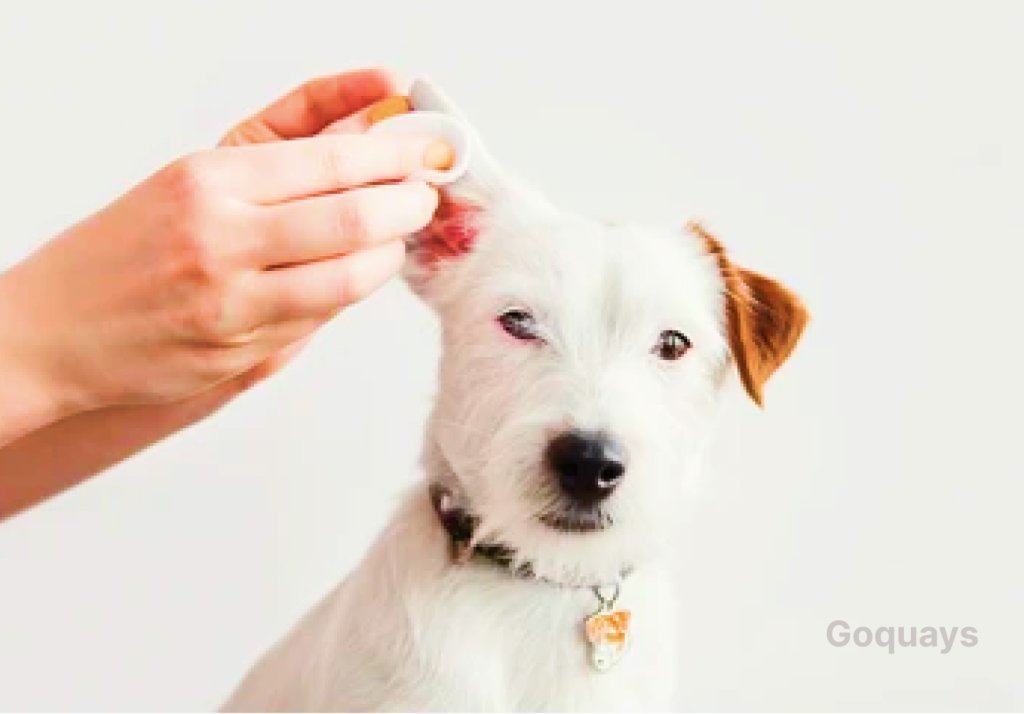
Keeping your dog’s ears healthy doesn’t have to be complicated. A few simple daily habits can make a big difference and help prevent itchy ears before they even start. Most ear issues come from a build-up of dirt, moisture, or allergens, and regular care can keep all of that under control.
Start with regular ear checks. Just take a few moments each day to look inside your dog’s ears. They should be clean, pale pink, and free of any strong smell or discharge. If you spot redness, dark wax, or your dog flinches when touched, it could be a sign of a brewing problem.
Grooming also plays a big part. Dogs with floppy ears or lots of hair around the ear canal may need trimming to improve air circulation. Moisture gets trapped easily in those areas, which creates the perfect spot for bacteria or yeast to grow. After baths or swims, gently dry your dog’s ears with a soft towel.
Use a vet-recommended ear cleaner once or twice a week. This keeps wax and dirt from building up. Never use harsh products like alcohol or hydrogen peroxide—they can irritate the ear and do more harm than good.
If your dog has had chronic ear infections, long-term care becomes even more important. Some dogs need weekly cleanings or daily allergy meds to keep flare-ups at bay. Stick to your vet’s plan and track any changes in behavior.
And yes, you absolutely can prevent many ear infections. While you can’t control every cause—like allergies or breed-related risks—staying consistent with checks, cleaning, and grooming goes a long way. Prevention keeps your dog more comfortable and saves you from repeated vet visits in the long run.
Breeds Prone to Ear Problems

Some dog breeds are just more likely to deal with ear issues. It’s not about how clean you keep them—sometimes, it’s all about genetics. Dogs with long, floppy ears like Cocker Spaniels, Basset Hounds, and Golden Retrievers have ears that hang down and trap moisture. That warm, dark space becomes the perfect place for bacteria and yeast to grow.
Breeds with lots of hair inside their ears—think Poodles or Shih Tzus—can also run into trouble. The extra hair blocks airflow, which leads to stuffy, irritated ears. Then you have dogs who love water or digging in the dirt. Their adventurous nature means their ears are constantly collecting moisture or debris, and infections follow fast.
Even some short-eared breeds can struggle. Bulldogs, for example, often have narrow ear canals and skin folds, which can cause trapped dirt and bacteria. If you have one of these breeds, regular ear checks should be part of your weekly routine. Look for redness, scratching, or head shaking. Catching signs early makes a big difference.
Your vet can show you the safest way to clean your dog’s ears based on their breed. You might even need trimming, drying agents, or more frequent checkups. Knowing your dog’s risk factors helps you take action before problems start. It’s all about staying one step ahead.
How Diet and Nutrition Affect Ear Health

Your dog’s diet does more than fuel playtime—it also affects how healthy their ears are. Food allergies are one of the most overlooked causes of chronic ear infections. If your dog’s ears are always red, itchy, or smelly, it might not be a cleaning issue. It could be something in their food bowl.
Common triggers include beef, chicken, dairy, wheat, or soy. When your dog eats something they’re sensitive to, the immune system reacts with inflammation. That inflammation often shows up in the skin and ears first. You might also notice them licking their paws, scratching more, or getting hot spots.
Switching to a limited ingredient or hypoallergenic diet can help. Some dogs also benefit from added omega-3 fatty acids, which reduce inflammation and support skin health. You’ll find those in fish oil or special veterinary diets.
Before changing your dog’s food, chat with your vet. They can recommend an elimination diet to figure out the trigger. Don’t just guess—it’s easy to make changes that seem right but miss the real issue. A good diet won’t solve every ear problem, but it plays a bigger role than most people realise.
Seasonal Allergies and Ear Irritation
If your dog’s ears get itchy in spring or fall, allergies might be the reason. Dogs react to environmental allergens like pollen, dust mites, and mould—just like we do. But instead of sneezing or getting watery eyes, dogs often get itchy skin, constant scratching, or ear problems.
These reactions cause the skin in the ear to become red, swollen, and vulnerable to infection. You might notice head shaking, a strong smell, or discharge. For some dogs, it happens like clockwork every year.
If symptoms show up during certain seasons, track them. Keep a note of what months the flare-ups happen and what the weather’s like. That can help your vet confirm if seasonal allergies are the cause.
Treatment usually includes antihistamines, ear cleaners, or even prescription meds. In some cases, your vet might suggest allergy testing or long-term allergy management like immunotherapy.
Cleaning your dog’s ears more often during high allergy seasons also helps. Wipe away pollen, dust, or debris that gets trapped inside. A good routine can ease symptoms and keep your dog more comfortable.
You can’t always avoid allergens, but you can manage the effects. Knowing the signs and acting quickly makes all the difference.
Ear Care Tips for Dogs That Swim Often

Dogs who love swimming are more likely to end up with ear infections. All that splashing around means extra moisture in the ears, which can be a breeding ground for bacteria and yeast. If your dog dives into lakes, pools, or even the garden hose, you’ll need an ear care routine that matches their lifestyle.
Start with drying. After every swim, gently dry your dog’s ears with a clean towel. Don’t stick anything deep into the canal—just pat around the opening. You can also use a vet-approved drying solution to help evaporate any leftover water.
It’s a good idea to clean your dog’s ears with an ear rinse made for dogs who swim. These usually have drying agents and ingredients that fight off infection. Don’t use human products—they can irritate your dog’s ears or throw off the natural balance.
If you swim often, check your dog’s ears at least twice a week. Look for redness, discharge, or any signs of discomfort. You’ll also want to talk to your vet about preventive care, especially if infections keep coming back.
A simple five-minute routine after a swim can save you from weeks of medication later. If your dog lives for the water, give their ears the same attention you give their coat or paws.
How to Tell the Difference Between Normal Ear Wax and Infection
Some ear wax is completely normal—it helps protect the ear and trap dirt. But knowing the difference between harmless buildup and a real infection can be tricky. If you’ve ever asked yourself, “Is that smell normal?” you’re not alone.
Healthy ear wax is usually light brown or yellowish. It doesn’t smell strong, and your dog shouldn’t scratch at it. A little bit of wax around the opening of the ear is nothing to worry about.
But if the wax turns dark brown, black, or greenish, that’s a warning sign. If it’s thick, gooey, or smells bad, infection might already be setting in. Other signs include redness, swelling, frequent scratching, or your dog shaking their head more than usual.
You can create a simple checklist:
- Light wax, no smell, no scratching = likely normal
- Dark wax, strong odour, head shaking = time for the vet
Some pet parents even take pictures during cleanings to compare over time. This helps you spot changes early. And if something seems off, trust your instincts—it’s better to get it checked than wait.
Conclusion
Dog itchy ears are more than just an annoying habit—they’re often a sign that something deeper is going on. From allergies to infections, there are many reasons your dog might be scratching or shaking its head. The good news is, with regular checks, good grooming habits, and timely vet care, you can stay ahead of most problems.
Don’t ignore the early signs like redness, smell, or constant scratching. If home remedies don’t help or things seem to get worse, contact your vet quickly. The sooner you act, the better the outcome for your dog.
By staying alert and keeping up with daily habits, you’re giving your dog a better chance at long-term ear health and everyday comfort.


